CBR23 – Ciotola barocco
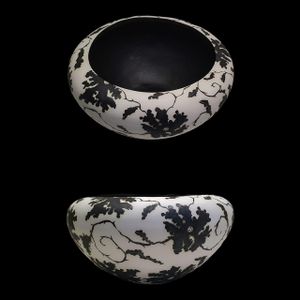
Elica Studio > Styling
Name: CBR23 – Ciotola barocco Material: Porcelain, glaze Finishing: Matte Sizes (cm): Approx. 28 × 28 × 15 Weight (g): ~900 Designed in: 2023 Collection: Naturalia Lead Time: 30 days Description: The CBR23 – Ciotola Barocco, a stunning bowl from Elica Studio's celebrated "Naturalia" collection, offers a sophisticated reinterpretation of classic elegance tailored for the modern interior designer. Designed in 2023, this piece is far more than a simple vessel; it is a meticulously crafted work of art that marries historical grandeur with contemporary minimalist sensibilities. Its captivating design and versatile form make it an essential element for creating refined and artistically rich interior spaces. Crafted from high-quality porcelain, the CBR23 – Ciotola Barocco features an exquisite matte glaze finish that lends it a soft, tactile presence and diffuses light beautifully, enhancing its intricate details. As depicted in the accompanying image, the bowl is adorned with a rich, baroque-inspired botanical pattern in striking black and white. This elaborate motif of intertwining vines, abundant leaves, and possibly floral elements covers the exterior, creating a dramatic visual narrative. The contrast between the dark, detailed imagery and the pristine white background is both bold and elegant, evoking the timeless charm of classical engravings while maintaining a fresh, contemporary feel. The interior of the bowl is finished in a deep, uniform black, which offers a striking contrast to the patterned exterior and adds an element of unexpected depth and sophistication. The monochrome palette of black and white is a deliberate artistic choice, ensuring the bowl's versatility across a wide spectrum of interior design styles. Whether integrated into a stark modern environment, a classic and opulent setting, or an eclectic contemporary space, the CBR23 – Ciotola Barocco stands out as a focal point. It injects a sense of refined drama and historical elegance without overwhelming the existing decor. The 'baroque' influence, interpreted through this minimalist color scheme, allows for a subtle nod to historical luxury, making the piece feel both timeless and current. It's an ideal choice for designers looking to introduce visual texture and artistic narrative into their projects without resorting to overt color. With dimensions of approximately 28 cm in diameter and 15 cm in height, and weighing a lightweight yet substantial 900 grams, the CBR23 – Ciotola Barocco is perfectly proportioned for various applications. It serves as an impressive centerpiece on a dining table, a decorative accent on a coffee table, or a curated addition to a console or shelving unit. Its wide, open form makes it suitable for displaying decorative objects, natural elements like stones or dried botanicals, or simply as a standalone sculpture. The "Naturalia" collection explores the beauty of nature through abstract and artistic interpretations, and this "baroque" bowl, with its organic yet stylized botanical patterns, harmoniously aligns with this theme, bringing a touch of the natural world refined through artistry into the home. Designed in 2023, the CBR23 – Ciotola Barocco is a testament to Elica Studio's commitment to creating pieces that are both aesthetically compelling and enduring. For interior designers seeking to imbue their projects with unique character, sophisticated contrast, and a timeless artistic sensibility, this bowl is an unparalleled selection. Its intricate detailing, elegant form, and commanding visual presence make it a truly memorable piece that will be admired for its beauty and conceptual depth. With a standard lead time of 30 days, incorporating this exceptional piece into project timelines is seamless, promising to deliver a profound artistic statement that enhances the overall ambiance of any discerning interior.
CHORISIA-2
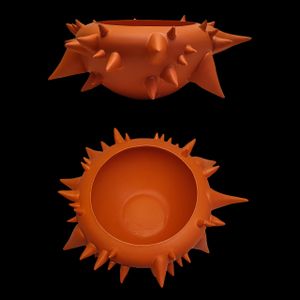
Elica Studio > Styling
Name: CHORISIA-2 Material: Porcelain, engobes, oxides, glaze Finishing: Matte Sizes (cm): Approx. 40 (diameter/width) × 16 (height) Weight (g): ~2400 Designed in: 2021 Collection: Naturalia Lead Time: 30 days Description: The CHORISIA-2, an extraordinary sculptural bowl from Elica Studio's compelling "Naturalia" collection, represents a vibrant evolution of its biomorphic design, specifically crafted to ignite imagination and captivate attention in refined interiors. Designed in 2021, this piece is a testament to the studio's innovative spirit, offering interior designers a truly unique statement for spaces that demand originality, artistic courage, and a tangible connection to the more vibrant aspects of the natural world. It masterfully balances a seemingly aggressive form with a warm, inviting hue, making it a powerful and versatile focal point in contemporary or eclectic design schemes. Meticulously crafted from high-quality porcelain, the CHORISIA-2 features a comprehensive application of engobes, oxides, and glaze, culminating in a distinctive matte finish. This treatment lends the piece a warm, tactile presence, enhancing its sculptural quality and preventing any harsh reflections. As vividly depicted in the accompanying image, the bowl’s most striking feature is its exterior, densely adorned with sharp, angular spikes that radiate outwards. These bold protrusions transform the conventional bowl form into a dynamic, almost defensive organic structure, reminiscent of a protective seed pod, a vibrant sea urchin, or even a stylized, sun-baked desert plant. The uniform orange/terracotta color deeply connects it to earthy tones, evoking sunsets, rich clays, or autumnal landscapes, while the matte finish provides an authentic, grounded feel. In stark contrast to its spiky, textural exterior, the interior of the CHORISIA-2 remains smooth and inviting, offering a serene, unblemished surface that emphasizes its functionality as a bowl while retaining its artistic integrity. This juxtaposition of a visually striking exterior with a refined, usable interior speaks to a thoughtful design philosophy that marries protection with receptivity. For interior designers, this piece offers unparalleled versatility. While it can serve as a dramatic decorative bowl for minimalist objects, its primary impact lies in its sculptural presence. It’s an ideal choice for a prominent position on a large coffee table, a console in an open-plan living space, or as a distinctive element within a curated art collection, injecting a burst of sophisticated color. Weighing approximately 2400 grams and measuring around 40 cm in its widest dimension with a height of 16 cm, the CHORISIA-2 possesses a substantial yet accessible presence. Its unique form ensures it commands attention without overwhelming the space, making it suitable for a variety of high-end residential and commercial environments. The "Naturalia" collection explores the abstract beauty of the natural world, and the CHORISIA-2, with its vibrant, thorny, almost botanical appearance, perfectly encapsulates this theme. It introduces an element of wild, untamed nature, yet presented in a highly refined and artistic manner. This piece speaks to a desire for raw, authentic beauty, interpreted through the lens of sophisticated ceramic craftsmanship, with an added layer of warm, inviting color. Designed in 2021, the CHORISIA-2 maintains its contemporary relevance, establishing itself as a timeless piece that continues to push the boundaries of decorative art. For interior designers seeking to imbue their projects with a sense of fearless style, tactile intrigue, and a definitively unique statement in a captivating hue, this bowl is an exceptional choice. Its daring form, meticulous craftsmanship, and striking visual impact make it a truly memorable addition. With a standard lead time of 30 days, incorporating this exceptional piece into project timelines is straightforward, promising to deliver a profound artistic statement that elevates the overall ambiance of any discerning interior, inviting contemplation and admiration for its extraordinary design and vibrant character.
BEGONIAS
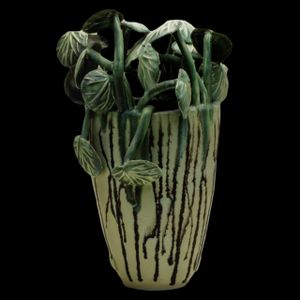
Elica Studio > Styling
Name: EGONIAS Material: Stoneware, engobes, oxides, glaze Finishing: Matte Sizes (cm): Approx. 26 (diameter/width) × 40 (height) Weight (g): ~4000 Designed in: 2012 Collection: Naturalia Lead Time: 30 days Description: The EGONIAS, a captivating and richly textured sculpture from Elica Studio's celebrated "Naturalia" collection, offers a unique blend of organic inspiration and refined artistry, meticulously designed to enrich sophisticated interior spaces. Created in 2012, this piece is more than a decorative item; it is a testament to the enduring beauty of botanical forms, reinterpreted through a contemporary lens, making it an exceptional addition for interior designers seeking to infuse projects with natural elegance and artistic depth. Crafted from robust stoneware, the EGONIAS boasts a distinctive dual aesthetic, seamlessly merging a structured base with a profusion of organic forms. The main body of the sculpture, as seen in previous similar designs, is likely characterized by a clean, elegant silhouette, potentially adorned with subtle textures or patterns that enhance its foundational appeal. The entire piece is treated with a matte finish, achieved through the expert application of engobes, oxides, and glaze. This refined surface treatment absorbs light beautifully, highlighting the intricate details and tactile qualities of the stoneware, creating a warm, inviting presence. The defining feature of the EGONIAS, consistent with its botanical name, lies in its meticulously sculpted elements that evoke lush, cascading foliage, reminiscent of begonia leaves. These organic forms are rendered with exquisite detail, showcasing lifelike veins and naturalistic contours, giving them an almost living quality. The use of oxides within the material likely contributes to varied green or earthy tones in these leafy elements, enhancing their naturalistic appeal and creating a beautiful contrast with the vase's base. This harmonious interplay between the structured vessel and the fluid, abundant foliage creates a dynamic composition that is both visually striking and profoundly serene. The versatility of the EGONIAS is a significant asset for interior designers. It introduces a vibrant touch of nature and sculptural form into any setting, whether it's a minimalist space needing an organic focal point or a richly layered interior seeking an artisanal accent. Its connection to the "Naturalia" collection emphasizes its inspiration from the natural world, allowing it to seamlessly integrate into biophilic design themes, bringing the tranquility and beauty of the outdoors inside. With dimensions of approximately 26 cm in width (or diameter) and a notable 40 cm in height, and weighing a substantial 4000 grams, the EGONIAS possesses a commanding yet balanced presence. Its robust nature and versatile size make it an ideal centerpiece for a dining table, a distinctive accent on a large console in an entryway, or a curated addition to a sophisticated lounge area or high-end commercial space. The deliberate design, rooted in 2012, ensures its timeless appeal, affirming its sustained relevance in contemporary interiors. For interior designers seeking to imbue their projects with unique character, a sense of lush vitality, and a profound artistic sensibility, the EGONIAS is an unparalleled choice. Its intricate details, substantial form, and refined finish position it as an investment piece that will resonate with clients who appreciate bespoke quality, enduring design, and a connection to the artistry of nature. With a standard lead time of 30 days, incorporating this exceptional sculpture into project timelines is straightforward, promising to deliver a profound visual and textural experience that enhances the overall ambiance of any sophisticated interior.
BEGONIAS
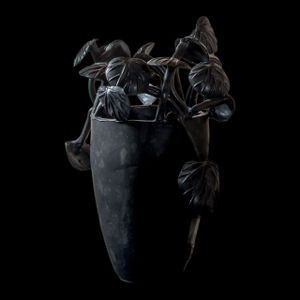
Elica Studio > Styling
Name: BEGONIAS Material: Stoneware, engobes, oxides, glaze Finishing: Matte Sizes (cm): Approx. 33 (diameter/width) × 49 (height) Weight (g): ~5800 Designed in: 2015 Collection: Naturalia Lead Time: 30 days Description: The BEGONIAS, an exquisitely rendered and profoundly evocative sculpture from Elica Studio's celebrated "Naturalia" collection, offers a unique blend of organic inspiration and artistic drama, meticulously designed to enrich sophisticated interior spaces. Created in 2015, this piece is more than a decorative item; it is a testament to the enduring beauty of botanical forms, reinterpreted through a contemporary lens and a dramatic monochrome palette, making it an exceptional addition for interior designers seeking to infuse projects with natural elegance and artistic depth. Crafted from robust stoneware, the BEGONIAS boasts a striking monochromatic aesthetic, seamlessly merging a structured vessel with a profusion of organic forms. As vividly illustrated in the accompanying image, the main body of the sculpture is a deep, rich black, achieved through the expert application of engobes and oxides. The entire piece is treated with a matte glaze, which absorbs light beautifully, emphasizing the textural qualities of the stoneware and the intricate details of the design without harsh reflections, lending it a formidable and elegant presence. The defining feature of the BEGONIAS, consistent with its botanical name, lies in its meticulously sculpted elements that evoke lush, cascading foliage, reminiscent of begonia leaves. These organic forms are rendered with exquisite detail, showcasing lifelike veins and naturalistic contours, giving them an almost living quality. Crucially, these leaves are also presented in the same deep, matte black as the vase, creating a cohesive, sculptural silhouette where form and shadow dictate its visual impact. The absence of contrasting color emphasizes the interplay of light and shadow across the sculpted leaves, bringing a dynamic sense of movement and depth to the piece. This artistic choice results in a powerful, sophisticated statement that draws the eye and encourages closer inspection of its intricate textures and forms. The monochromatic black palette of the BEGONIAS offers remarkable versatility for interior designers. It introduces a powerful, grounding element into minimalist spaces, providing intricate detail without adding visual clutter. In richly layered or eclectic interiors, it acts as a sophisticated anchor, harmonizing with diverse textures and colors while asserting its unique artistic presence. Its connection to the "Naturalia" collection emphasizes its inspiration from the natural world, allowing it to seamlessly integrate into biophilic design themes, bringing the tranquil yet dramatic beauty of the outdoors inside, presented in an artful, enduring medium. With dimensions of approximately 33 cm in width (or diameter) and a notable 49 cm in height, and weighing a substantial 5800 grams, the BEGONIAS possesses a commanding yet balanced presence. Its robust nature and versatile size make it an ideal centerpiece for a dining table, a distinctive accent on a large console in an entryway, or a curated addition to a sophisticated lounge area or high-end commercial space. The deliberate design, rooted in 2015, ensures its timeless appeal, affirming its sustained relevance in contemporary interiors. For interior designers seeking to imbue their projects with unique character, a sense of dramatic elegance, and a profound artistic sensibility, the BEGONIAS is an unparalleled choice. Its intricate details, substantial form, and refined finish position it as an investment piece that will resonate with clients who appreciate bespoke quality, enduring design, and a profound connection to the artistry of nature. With a standard lead time of 30 days, incorporating this exceptional sculpture into project timelines is straightforward, promising to deliver a profound visual and textural experience that enhances the overall ambiance of any sophisticated interior.
BEGONIAS
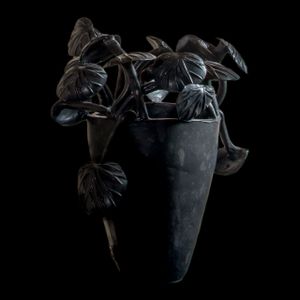
Elica Studio > Styling
Name: EGONIAS Material: Stoneware, engobes, oxides, glaze Finishing: Matte Sizes (cm): Approx. 26 (diameter/width) × 40 (height) Weight (g): ~4000 Designed in: 2015 Collection: Naturalia Lead Time: 30 days Description: The EGONIAS, a captivating and richly textured sculpture from Elica Studio's celebrated "Naturalia" collection, offers a unique blend of organic inspiration and refined artistry, meticulously designed to enrich sophisticated interior spaces. Created in 2015, this piece is more than a decorative item; it is a testament to the enduring beauty of botanical forms, reinterpreted through a contemporary lens, making it an exceptional addition for interior designers seeking to infuse projects with natural elegance and artistic depth. Crafted from robust stoneware, the EGONIAS boasts a distinctive dual aesthetic, seamlessly merging a structured base with a profusion of organic forms. The main body of the sculpture is likely characterized by a clean, elegant silhouette, potentially adorned with subtle textures or patterns that enhance its foundational appeal. The entire piece is treated with a matte finish, achieved through the expert application of engobes, oxides, and glaze. This refined surface treatment absorbs light beautifully, highlighting the intricate details and tactile qualities of the stoneware, creating a warm, inviting presence. The defining feature of the EGONIAS, consistent with its botanical name, lies in its meticulously sculpted elements that evoke lush, cascading foliage, reminiscent of begonia leaves. These organic forms are rendered with exquisite detail, showcasing lifelike veins and naturalistic contours, giving them an almost living quality. The use of oxides within the material likely contributes to varied green or earthy tones in these leafy elements, enhancing their naturalistic appeal and creating a beautiful contrast with the vase's base. This harmonious interplay between the structured vessel and the fluid, abundant foliage creates a dynamic composition that is both visually striking and profoundly serene. The versatility of the EGONIAS is a significant asset for interior designers. It introduces a vibrant touch of nature and sculptural form into any setting, whether it's a minimalist space needing an organic focal point or a richly layered interior seeking an artisanal accent. Its connection to the "Naturalia" collection emphasizes its inspiration from the natural world, allowing it to seamlessly integrate into biophilic design themes, bringing the tranquility and beauty of the outdoors inside. With dimensions of approximately 26 cm in width (or diameter) and a notable 40 cm in height, and weighing a substantial 4000 grams, the EGONIAS possesses a commanding yet balanced presence. Its robust nature and versatile size make it an ideal centerpiece for a dining table, a distinctive accent on a large console in an entryway, or a curated addition to a sophisticated lounge area or high-end commercial space. The deliberate design, rooted in 2015, ensures its timeless appeal, affirming its sustained relevance in contemporary interiors. For interior designers seeking to imbue their projects with unique character, a sense of lush vitality, and a profound artistic sensibility, the EGONIAS is an unparalleled choice. Its intricate details, substantial form, and refined finish position it as an investment piece that will resonate with clients who appreciate bespoke quality, enduring design, and a connection to the artistry of nature. With a standard lead time of 30 days, incorporating this exceptional sculpture into project timelines is straightforward, promising to deliver a profound visual and textural experience that enhances the overall ambiance of any sophisticated interior.
NINPHAEAE (wall elements) NFB10 –NFG10 – NFM10 – NFP10
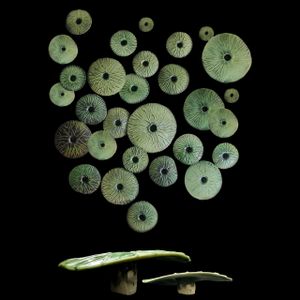
Elica Studio > Styling
Name: INPHAEAE (wall elements) NFB10 – NFG10 – NFM10 – NFP10 Material: Stoneware, engobes, oxides, glaze Finishing: Matte Sizes (cm): Approx. 39, 30, 25 (diameter/width) Weight (g): ~2200 (per piece) Designed in: 2010 Collection: Naturalia Lead Time: 30 days Description: The INPHAEAE wall elements, a compelling and innovative collection from Elica Studio's "Naturalia" series, offer interior designers an exceptional opportunity to create dynamic, textural, and artistically rich wall installations. Designed in 2010, these modular pieces are more than mere decor; they are sculptural components that invite bespoke arrangements, transforming flat surfaces into vibrant, three-dimensional canvases. Rooted in the subtle intricacies of the natural world, the INPHAEAE elements provide a sophisticated touch of organic modernism. Crafted from robust stoneware, each INPHAEAE element is meticulously finished with engobes, oxides, and glaze, resulting in a rich, matte surface. This refined treatment absorbs light beautifully, highlighting the intricate textures and earthy tones without harsh reflections. As vividly illustrated in the accompanying image, these elements are circular, disc-like forms, presented in varying sizes (approximately 39 cm, 30 cm, and 25 cm in diameter). Their surfaces are characterized by a captivating array of organic textures, including radiating lines, subtle undulations, and a prominent central depression or aperture. This detailing evokes the delicate structures of microscopic marine life, fossilized imprints, or the complex patterns found within seeds and spores, linking directly to the "Naturalia" collection's ethos. The range (NFB10 – NFG10 – NFM10 – NFP10) indicates a selection of potential finishes, with the depicted elements showcasing a spectrum of sophisticated greens. These verdant hues, achieved through carefully balanced oxides, range from muted sage to deeper forest tones, mimicking the natural variation found in botanical and aquatic environments. This palette allows for the creation of cohesive yet visually diverse arrangements, enabling designers to evoke a sense of organic growth and natural movement across a wall. The matte finish enhances the raw, tactile quality of the stoneware, inviting touch and adding a grounding presence to any interior scheme. Weighing approximately 2200 grams per piece, these wall elements possess a substantial yet manageable weight, ensuring stability when installed while facilitating flexible arrangements. Their modular nature is a significant advantage for interior designers, allowing for custom compositions that can be scaled to fit any space, from an intimate accent wall in a luxury residence to a grand installation in a high-end commercial lobby or hospitality venue. They can be arranged in dense clusters for a dramatic effect, or sparsely placed to create a subtle rhythm, bringing a bespoke, art-gallery feel to the environment. Designed in 2010, the INPHAEAE wall elements demonstrate a timeless aesthetic that remains highly relevant in contemporary design. They are particularly well-suited for projects where designers seek to integrate biophilic elements, create unique textural narratives, and introduce a sense of serene, understated luxury. Their blend of organic form, subtle color variation, and tactile appeal positions them as an investment in enduring artistry. With a standard lead time of 30 days, incorporating these exceptional wall elements into project timelines is straightforward, promising to deliver a profound visual and textural experience that transforms ordinary walls into captivating artistic statements, leaving a lasting impression of refined taste and natural sophistication.
NIGRUM

Elica Studio > Styling
Name: NIGRUM Material: Stoneware, engobes, oxides Finishing: Matte Sizes (cm): Approx. 45 × 45 × 40 (Height × Width × Depth) Weight (g): ~7500 Designed in: 2012 Collection: Naturalia Lead Time: 30 days Description: The NIGRUM, a profoundly enigmatic and powerfully sculptural object from Elica Studio's compelling "Naturalia" collection, offers an exploration into the darker, more abstract facets of organic life and natural decay. Designed in 2012, this piece is an extraordinary statement for interior designers seeking to introduce elements of raw artistic intensity, sophisticated mystery, and a unique biomorphic intrigue into their curated spaces. It embodies a fascinating dialogue between the resilience of form and the melancholic beauty of transformation, making it a compelling focal point in high-end contemporary, gothic-inspired, or avant-garde design schemes. Masterfully crafted from robust stoneware, the NIGRUM is characterized by its deep, uniform black aesthetic, achieved through the expert application of engobes and oxides. The entire piece is finished with a sophisticated matte surface, which absorbs light beautifully, emphasizing its complex textures and forms without harsh reflections. As vividly illustrated in the accompanying image, the NIGRUM presents as a substantial, spherical base, subtly speckled with lighter flecks that create an almost cosmic or weathered appearance, reminiscent of a celestial body or ancient stone. From this solid foundation, a dense array of intricate, branching structures vigorously emerges. These striking elements, also rendered in matte black, resemble an abstract forest of bare branches, coral formations, or perhaps the intricate root systems exposed from the earth. Their organic, almost gnarled quality adds a raw, untamed dimension to the piece. The interplay between the smooth, rounded base and the chaotic, dynamic branches creates a captivating visual and tactile contrast, inviting closer inspection. The monochrome black palette of the NIGRUM enhances its dramatic presence, allowing its extraordinary form and textural complexity to command full attention. Without the distraction of color, the viewer is drawn into the sculptural narrative, pondering its origins and symbolism. The NIGRUM, with its unique blend of organic abstraction and powerful visual impact, offers remarkable versatility for interior designers. It introduces a powerful, grounding presence in minimalist environments, providing intricate detail and a profound sense of artistic depth. In richly textured or eclectic interiors, it acts as a sophisticated anchor, harmonizing with diverse materials while asserting its unique, almost otherworldly presence. Its strong connection to the "Naturalia" collection is evident in its derivation from natural forms, albeit interpreted in a dark, sculptural, and highly abstract manner, creating a bridge between raw nature and refined art. Weighing a substantial 7500 grams and measuring approximately 45 cm in its various dimensions (height, width, depth), the NIGRUM possesses a commanding and weighty presence. Its robust nature and versatile size make it an ideal centerpiece for a substantial coffee table, a compelling accent on a large console in an entryway, or a curated addition to a sophisticated lounge area or high-end commercial space. Designed in 2012, the NIGRUM continues to stand as a testament to enduring design and timeless appeal, proving its sustained relevance in contemporary interiors. For interior designers seeking to imbue their projects with unique character, a sense of dark elegance, and a profound artistic sensibility, the NIGRUM is an unparalleled choice. Its intricate details, substantial form, and captivating visual impact position it as an investment piece that will resonate with clients who appreciate bespoke quality, enduring design, and a connection to the artistic exploration of nature's profound mysteries. With a standard lead time of 30 days, incorporating this exceptional sculpture into project timelines is straightforward, promising to deliver a profound visual and textural experience that enhances the overall ambiance of any sophisticated interior.
HISTORIA
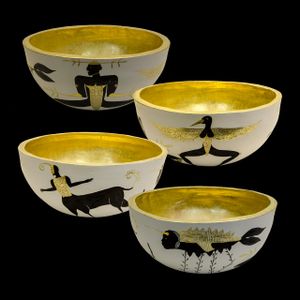
Elica Studio > Styling
Name: HISTORIA Material: Porcelain, glaze, oxides Finishing: Matte (exterior), Glossy (interior) Sizes (cm): Approx. 37 (diameter) × 17 (height) Weight (g): ~3900 (per bowl) Designed in: 2007 Collection: Naturalia Lead Time: 30 days Description: The HISTORIA bowls, an exceptionally artistic and narratively rich collection from Elica Studio's profound "Naturalia" series, offer a captivating journey into ancient tales and mythical forms, meticulously rendered to adorn the most sophisticated interiors. Designed in 2007, these pieces are more than functional vessels; they are sculptural canvases that tell stories, inviting contemplation and enriching spaces with a unique blend of historical reverence and contemporary elegance. They embody a fascinating dialogue between classic storytelling and modern craftsmanship, making them compelling focal points in high-end eclectic, artistic, or culturally inspired design schemes. Masterfully crafted from fine porcelain, each HISTORIA bowl is a testament to intricate artistry and material contrast. The exterior of the bowls features a sophisticated matte finish, achieved through the expert application of oxides, providing a refined, understated canvas for the detailed illustrations. As vividly illustrated in the accompanying image, the external surfaces are adorned with stylized figures and patterns in deep black, set against a pristine white porcelain backdrop. These depictions are highly evocative, featuring humanoid forms with animalistic attributes, mythological creatures like centaurs, and winged beings, all rendered with a distinct, ancient, almost folkloric aesthetic. The meticulous detailing, from flowing hair to intricate musculature and symbolic motifs, speaks to a deep well of inspiration drawn from classical or tribal narratives. In striking contrast to the matte, monochromatic exterior, the interior of each HISTORIA bowl boasts a resplendent, highly glossy gold finish, achieved through a lustrous glaze. This brilliant gold not only provides a luxurious surprise upon viewing the interior but also creates a captivating interplay of light, reflecting and amplifying the surrounding environment. This duality – the understated, story-rich exterior meeting the opulent, radiant interior – imbues the bowls with a profound sense of hidden depth and discovery. The material composition of porcelain, glaze, and oxides ensures durability while allowing for the exquisite detail and vibrant metallic luster. The HISTORIA bowls, with their unique blend of narrative art, contrasting finishes, and luxurious materials, offer remarkable versatility for interior designers. They can function as exquisite decorative objects on their own, whether displayed individually or as a curated set, commanding attention on a console, coffee table, or as art within bespoke shelving. They are perfect for introducing a touch of cultural depth and bespoke artistry into minimalist settings, or for complementing richly textured and eclectic interiors. The connection to the "Naturalia" collection is subtly present in their organic forms and the timelessness of their narrative, echoing the enduring stories found in nature and human history. With generous dimensions of approximately 37 cm in diameter and 17 cm in height, and weighing around 3900 grams per bowl, the HISTORIA pieces possess a substantial and impressive presence. Their robust nature and considered size make them ideal for making a significant statement in luxury residences, high-end hotel lobbies, or executive offices. Designed in 2007, the HISTORIA collection continues to stand as a testament to enduring design and timeless appeal, proving its sustained relevance in contemporary interiors. For interior designers seeking to imbue their projects with unique character, a sense of refined artistry, and a profound narrative sensibility, the HISTORIA bowls are an unparalleled choice. Their intricate details, rich symbolism, and captivating aesthetic position them as investment pieces that will resonate with clients who appreciate bespoke quality, enduring design, and a connection to the artistic exploration of humanity's shared heritage. With a standard lead time of 30 days, incorporating these exceptional bowls into project timelines is straightforward, promising to deliver a profound visual and intellectual experience that enhances the overall ambiance of any sophisticated interior.
Terra Nova Mediterraneo Solid Tile: Squash

casatile > Floor tile-stone
Terra Nova Mediterraneo Tiles are made using the Maiolica ceramic technique. First, a tin-glaze layer on a terracotta tile is applied, then the tile is decorated over the glazed surface with other color glazes, and lastly it is fired in a kiln until it reaches the desired finish. The name Maiolica is thought to come from the medieval Italian word for Majorca, an island in the Mediterranean on the route followed by ships bringing Hispano-Moresque wares from Valencia to Italy. Moorish potters from Majorca are reputed to have worked in Sicily and it has been suggested that their wares reached the Italian mainland from Caltagirone, a town in the island of Sicily. Terra Nova tile collection delivers the stunning design and aesthetic solutions of authentic, old-world handcrafted decorative tiles, and at the same time meets technical requirements for applications of greater stress.
Terra Nova Mediterraneo Solid Tile: Light Green
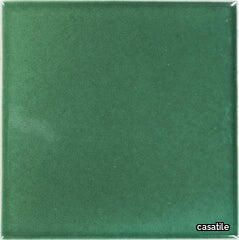
casatile > Floor tile-stone
Terra Nova Mediterraneo Tiles are made using the Maiolica ceramic technique. First, a tin-glaze layer on a terracotta tile is applied, then the tile is decorated over the glazed surface with other color glazes, and lastly it is fired in a kiln until it reaches the desired finish. The name Maiolica is thought to come from the medieval Italian word for Majorca, an island in the Mediterranean on the route followed by ships bringing Hispano-Moresque wares from Valencia to Italy. Moorish potters from Majorca are reputed to have worked in Sicily and it has been suggested that their wares reached the Italian mainland from Caltagirone, a town in the island of Sicily. Terra Nova tile collection delivers the stunning design and aesthetic solutions of authentic, old-world handcrafted decorative tiles, and at the same time meets technical requirements for applications of greater stress.
coral loose lay tiles anthracite
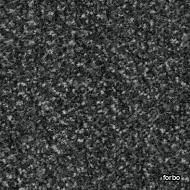
forbo > Carpet
Our Fast Flooring solution for your entrance system.For our Coral tiles we have developed a special installation method to help you secure the tiles: Pro-Fit Quattro. Hook and loop patches are being laid on the corners holding the tiles together. This way the tiles can be installed loose laid and the installation time is considerably reduced. Moreover, this Pro-Fit Quattro solution makes a circular installation possible because you can reuse the tiles for another location again.Two colours of the Brush and two colours of the Classic collection are available from stock.Other colours from the Coral Classic and Brush collection are available on request.
coral loose lay tiles raven black
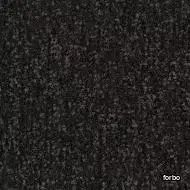
forbo > Carpet
Our Fast Flooring solution for your entrance system.For our Coral tiles we have developed a special installation method to help you secure the tiles: Pro-Fit Quattro. Hook and loop patches are being laid on the corners holding the tiles together. This way the tiles can be installed loose laid and the installation time is considerably reduced. Moreover, this Pro-Fit Quattro solution makes a circular installation possible because you can reuse the tiles for another location again.Two colours of the Brush and two colours of the Classic collection are available from stock.Other colours from the Coral Classic and Brush collection are available on request.
Andaluz Terra Nova Mediterraneo Qatar: Turquoise
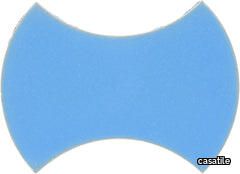
casatile > Floor tile-stone
Terra Nova Mediterraneo Tiles are made using the Maiolica ceramic technique. First, a tin-glaze layer on a terracotta tile is applied, then the tile is decorated over the glazed surface with other color glazes, and lastly it is fired in a kiln until it reaches the desired finish. The name Maiolica is thought to come from the medieval Italian word for Majorca, an island in the Mediterranean on the route followed by ships bringing Hispano-Moresque wares from Valencia to Italy. Moorish potters from Majorca are reputed to have worked in Sicily and it has been suggested that their wares reached the Italian mainland from Caltagirone, a town in the island of Sicily. Terra Nova tile collection delivers the stunning design and aesthetic solutions of authentic, old-world handcrafted decorative tiles, and at the same time meets technical requirements for applications of greater stress.
Andaluz Terra Nova Mediterraneo Andaluz: Snow White
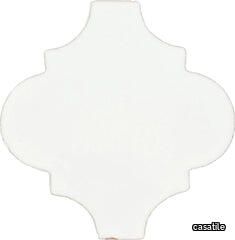
casatile > Floor tile-stone
Terra Nova Mediterraneo Tiles are made using the Maiolica ceramic technique. First, a tin-glaze layer on a terracotta tile is applied, then the tile is decorated over the glazed surface with other color glazes, and lastly it is fired in a kiln until it reaches the desired finish. The name Maiolica is thought to come from the medieval Italian word for Majorca, an island in the Mediterranean on the route followed by ships bringing Hispano-Moresque wares from Valencia to Italy. Moorish potters from Majorca are reputed to have worked in Sicily and it has been suggested that their wares reached the Italian mainland from Caltagirone, a town in the island of Sicily. Terra Nova tile collection delivers the stunning design and aesthetic solutions of authentic, old-world handcrafted decorative tiles, and at the same time meets technical requirements for applications of greater stress.
Andaluz Terra Nova Mediterraneo Andaluz: Nocturnal Sea
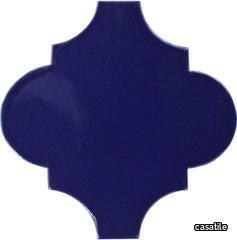
casatile > Floor tile-stone
Terra Nova Mediterraneo Tiles are made using the Maiolica ceramic technique. First, a tin-glaze layer on a terracotta tile is applied, then the tile is decorated over the glazed surface with other color glazes, and lastly it is fired in a kiln until it reaches the desired finish. The name Maiolica is thought to come from the medieval Italian word for Majorca, an island in the Mediterranean on the route followed by ships bringing Hispano-Moresque wares from Valencia to Italy. Moorish potters from Majorca are reputed to have worked in Sicily and it has been suggested that their wares reached the Italian mainland from Caltagirone, a town in the island of Sicily. Terra Nova tile collection delivers the stunning design and aesthetic solutions of authentic, old-world handcrafted decorative tiles, and at the same time meets technical requirements for applications of greater stress.
Terra Nova Mediterraneo Decorative Tile: Marseille Black & White
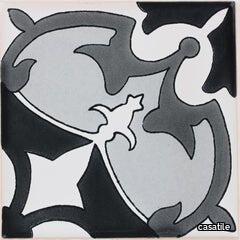
casatile > Floor tile-stone
Terra Nova Mediterraneo Tiles are made using the Maiolica ceramic technique. First, a tin-glaze layer on a terracotta tile is applied, then the tile is decorated over the glazed surface with other color glazes, and lastly it is fired in a kiln until it reaches the desired finish. The name Maiolica is thought to come from the medieval Italian word for Majorca, an island in the Mediterranean on the route followed by ships bringing Hispano-Moresque wares from Valencia to Italy. Moorish potters from Majorca are reputed to have worked in Sicily and it has been suggested that their wares reached the Italian mainland from Caltagirone, a town in the island of Sicily. Terra Nova tile collection delivers the stunning design and aesthetic solutions of authentic, old-world handcrafted decorative tiles, and at the same time meets technical requirements for applications of greater stress.
Terra Nova Mediterraneo Solid Tile: Snow White
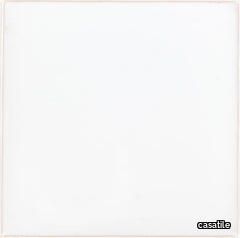
casatile > Floor tile-stone
Terra Nova Mediterraneo Tiles are made using the Maiolica ceramic technique. First, a tin-glaze layer on a terracotta tile is applied, then the tile is decorated over the glazed surface with other color glazes, and lastly it is fired in a kiln until it reaches the desired finish. The name Maiolica is thought to come from the medieval Italian word for Majorca, an island in the Mediterranean on the route followed by ships bringing Hispano-Moresque wares from Valencia to Italy. Moorish potters from Majorca are reputed to have worked in Sicily and it has been suggested that their wares reached the Italian mainland from Caltagirone, a town in the island of Sicily. Terra Nova tile collection delivers the stunning design and aesthetic solutions of authentic, old-world handcrafted decorative tiles, and at the same time meets technical requirements for applications of greater stress.
Terra Nova Mediterraneo Solid Tile: Rust
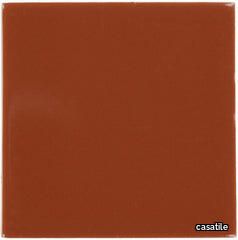
casatile > Floor tile-stone
Terra Nova Mediterraneo Tiles are made using the Maiolica ceramic technique. First, a tin-glaze layer on a terracotta tile is applied, then the tile is decorated over the glazed surface with other color glazes, and lastly it is fired in a kiln until it reaches the desired finish. The name Maiolica is thought to come from the medieval Italian word for Majorca, an island in the Mediterranean on the route followed by ships bringing Hispano-Moresque wares from Valencia to Italy. Moorish potters from Majorca are reputed to have worked in Sicily and it has been suggested that their wares reached the Italian mainland from Caltagirone, a town in the island of Sicily. Terra Nova tile collection delivers the stunning design and aesthetic solutions of authentic, old-world handcrafted decorative tiles, and at the same time meets technical requirements for applications of greater stress.
coral loose lay tiles hurricane grey
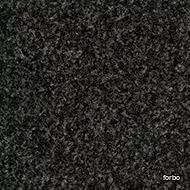
forbo > Carpet
Our Fast Flooring solution for your entrance system.For our Coral tiles we have developed a special installation method to help you secure the tiles: Pro-Fit Quattro. Hook and loop patches are being laid on the corners holding the tiles together. This way the tiles can be installed loose laid and the installation time is considerably reduced. Moreover, this Pro-Fit Quattro solution makes a circular installation possible because you can reuse the tiles for another location again.Two colours of the Brush and two colours of the Classic collection are available from stock.Other colours from the Coral Classic and Brush collection are available on request.
Andaluz Terra Nova Mediterraneo Riad: Light Green
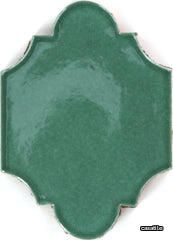
casatile > Floor tile-stone
Terra Nova Mediterraneo Tiles are made using the Maiolica ceramic technique. First, a tin-glaze layer on a terracotta tile is applied, then the tile is decorated over the glazed surface with other color glazes, and lastly it is fired in a kiln until it reaches the desired finish. The name Maiolica is thought to come from the medieval Italian word for Majorca, an island in the Mediterranean on the route followed by ships bringing Hispano-Moresque wares from Valencia to Italy. Moorish potters from Majorca are reputed to have worked in Sicily and it has been suggested that their wares reached the Italian mainland from Caltagirone, a town in the island of Sicily. Terra Nova tile collection delivers the stunning design and aesthetic solutions of authentic, old-world handcrafted decorative tiles, and at the same time meets technical requirements for applications of greater stress.
Andaluz Terra Nova Mediterraneo Riad: Snow White
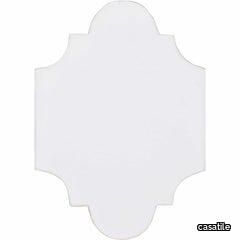
casatile > Floor tile-stone
Terra Nova Mediterraneo Tiles are made using the Maiolica ceramic technique. First, a tin-glaze layer on a terracotta tile is applied, then the tile is decorated over the glazed surface with other color glazes, and lastly it is fired in a kiln until it reaches the desired finish. The name Maiolica is thought to come from the medieval Italian word for Majorca, an island in the Mediterranean on the route followed by ships bringing Hispano-Moresque wares from Valencia to Italy. Moorish potters from Majorca are reputed to have worked in Sicily and it has been suggested that their wares reached the Italian mainland from Caltagirone, a town in the island of Sicily. Terra Nova tile collection delivers the stunning design and aesthetic solutions of authentic, old-world handcrafted decorative tiles, and at the same time meets technical requirements for applications of greater stress.
Terra Nova Mediterraneo Decorative Tile: Mosaico Azul
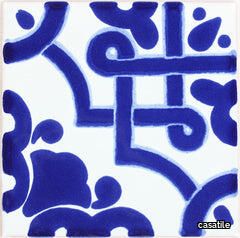
casatile > Floor tile-stone
Terra Nova Mediterraneo Tiles are made using the Maiolica ceramic technique. First, a tin-glaze layer on a terracotta tile is applied, then the tile is decorated over the glazed surface with other color glazes, and lastly it is fired in a kiln until it reaches the desired finish. The name Maiolica is thought to come from the medieval Italian word for Majorca, an island in the Mediterranean on the route followed by ships bringing Hispano-Moresque wares from Valencia to Italy. Moorish potters from Majorca are reputed to have worked in Sicily and it has been suggested that their wares reached the Italian mainland from Caltagirone, a town in the island of Sicily. Terra Nova tile collection delivers the stunning design and aesthetic solutions of authentic, old-world handcrafted decorative tiles, and at the same time meets technical requirements for applications of greater stress.
Terra Nova Mediterraneo Decorative Tile: Bari
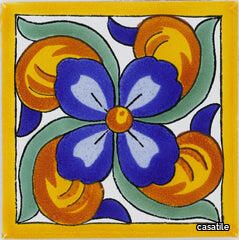
casatile > Floor tile-stone
Terra Nova Mediterraneo Tiles are made using the Maiolica ceramic technique. First, a tin-glaze layer on a terracotta tile is applied, then the tile is decorated over the glazed surface with other color glazes, and lastly it is fired in a kiln until it reaches the desired finish. The name Maiolica is thought to come from the medieval Italian word for Majorca, an island in the Mediterranean on the route followed by ships bringing Hispano-Moresque wares from Valencia to Italy. Moorish potters from Majorca are reputed to have worked in Sicily and it has been suggested that their wares reached the Italian mainland from Caltagirone, a town in the island of Sicily. Terra Nova tile collection delivers the stunning design and aesthetic solutions of authentic, old-world handcrafted decorative tiles, and at the same time meets technical requirements for applications of greater stress.
Terra Nova Mediterraneo Decorative Tile: Bellagio 1

casatile > Floor tile-stone
Terra Nova Mediterraneo Tiles are made using the Maiolica ceramic technique. First, a tin-glaze layer on a terracotta tile is applied, then the tile is decorated over the glazed surface with other color glazes, and lastly it is fired in a kiln until it reaches the desired finish. The name Maiolica is thought to come from the medieval Italian word for Majorca, an island in the Mediterranean on the route followed by ships bringing Hispano-Moresque wares from Valencia to Italy. Moorish potters from Majorca are reputed to have worked in Sicily and it has been suggested that their wares reached the Italian mainland from Caltagirone, a town in the island of Sicily. Terra Nova tile collection delivers the stunning design and aesthetic solutions of authentic, old-world handcrafted decorative tiles, and at the same time meets technical requirements for applications of greater stress.
Terra Nova Mediterraneo Solid Tile: Turquoise
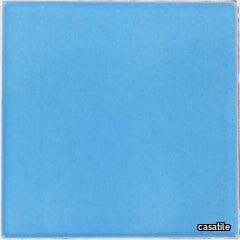
casatile > Floor tile-stone
Terra Nova Mediterraneo Tiles are made using the Maiolica ceramic technique. First, a tin-glaze layer on a terracotta tile is applied, then the tile is decorated over the glazed surface with other color glazes, and lastly it is fired in a kiln until it reaches the desired finish. The name Maiolica is thought to come from the medieval Italian word for Majorca, an island in the Mediterranean on the route followed by ships bringing Hispano-Moresque wares from Valencia to Italy. Moorish potters from Majorca are reputed to have worked in Sicily and it has been suggested that their wares reached the Italian mainland from Caltagirone, a town in the island of Sicily. Terra Nova tile collection delivers the stunning design and aesthetic solutions of authentic, old-world handcrafted decorative tiles, and at the same time meets technical requirements for applications of greater stress.
Terra Nova Mediterraneo Solid Tile: Light Blue
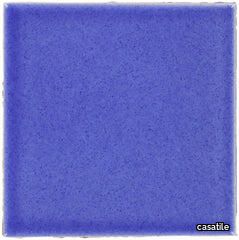
casatile > Floor tile-stone
Terra Nova Mediterraneo Tiles are made using the Maiolica ceramic technique. First, a tin-glaze layer on a terracotta tile is applied, then the tile is decorated over the glazed surface with other color glazes, and lastly it is fired in a kiln until it reaches the desired finish. The name Maiolica is thought to come from the medieval Italian word for Majorca, an island in the Mediterranean on the route followed by ships bringing Hispano-Moresque wares from Valencia to Italy. Moorish potters from Majorca are reputed to have worked in Sicily and it has been suggested that their wares reached the Italian mainland from Caltagirone, a town in the island of Sicily. Terra Nova tile collection delivers the stunning design and aesthetic solutions of authentic, old-world handcrafted decorative tiles, and at the same time meets technical requirements for applications of greater stress.
coral loose lay tiles asphalt grey
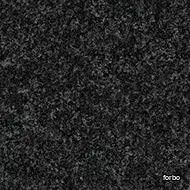
forbo > Carpet
Our Fast Flooring solution for your entrance system.For our Coral tiles we have developed a special installation method to help you secure the tiles: Pro-Fit Quattro. Hook and loop patches are being laid on the corners holding the tiles together. This way the tiles can be installed loose laid and the installation time is considerably reduced. Moreover, this Pro-Fit Quattro solution makes a circular installation possible because you can reuse the tiles for another location again.Two colours of the Brush and two colours of the Classic collection are available from stock.Other colours from the Coral Classic and Brush collection are available on request.
Terra Nova Mediterraneo Solid Tile: Nocturnal Sea
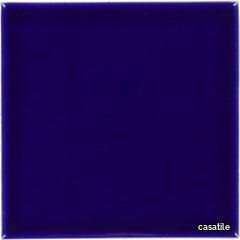
casatile > Floor tile-stone
Terra Nova Mediterraneo Tiles are made using the Maiolica ceramic technique. First, a tin-glaze layer on a terracotta tile is applied, then the tile is decorated over the glazed surface with other color glazes, and lastly it is fired in a kiln until it reaches the desired finish. The name Maiolica is thought to come from the medieval Italian word for Majorca, an island in the Mediterranean on the route followed by ships bringing Hispano-Moresque wares from Valencia to Italy. Moorish potters from Majorca are reputed to have worked in Sicily and it has been suggested that their wares reached the Italian mainland from Caltagirone, a town in the island of Sicily. Terra Nova tile collection delivers the stunning design and aesthetic solutions of authentic, old-world handcrafted decorative tiles, and at the same time meets technical requirements for applications of greater stress.
Terra Nova Mediterraneo Decorative Tile: Positano
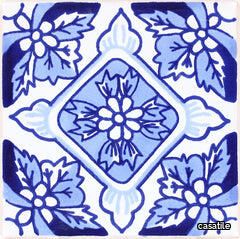
casatile > Floor tile-stone
Terra Nova Mediterraneo Tiles are made using the Maiolica ceramic technique. First, a tin-glaze layer on a terracotta tile is applied, then the tile is decorated over the glazed surface with other color glazes, and lastly it is fired in a kiln until it reaches the desired finish. The name Maiolica is thought to come from the medieval Italian word for Majorca, an island in the Mediterranean on the route followed by ships bringing Hispano-Moresque wares from Valencia to Italy. Moorish potters from Majorca are reputed to have worked in Sicily and it has been suggested that their wares reached the Italian mainland from Caltagirone, a town in the island of Sicily. Terra Nova tile collection delivers the stunning design and aesthetic solutions of authentic, old-world handcrafted decorative tiles, and at the same time meets technical requirements for applications of greater stress.
Terra Nova Mediterraneo Decorative Tile: Monterosso 2
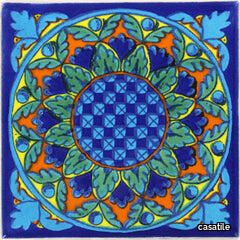
casatile > Floor tile-stone
Terra Nova Mediterraneo Tiles are made using the Maiolica ceramic technique. First, a tin-glaze layer on a terracotta tile is applied, then the tile is decorated over the glazed surface with other color glazes, and lastly it is fired in a kiln until it reaches the desired finish. The name Maiolica is thought to come from the medieval Italian word for Majorca, an island in the Mediterranean on the route followed by ships bringing Hispano-Moresque wares from Valencia to Italy. Moorish potters from Majorca are reputed to have worked in Sicily and it has been suggested that their wares reached the Italian mainland from Caltagirone, a town in the island of Sicily. Terra Nova tile collection delivers the stunning design and aesthetic solutions of authentic, old-world handcrafted decorative tiles, and at the same time meets technical requirements for applications of greater stress.
Terra Nova Mediterraneo Decorative Tile: Prisme Black & White
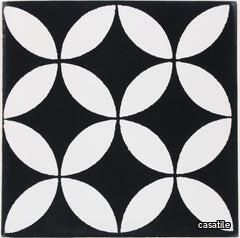
casatile > Floor tile-stone
Terra Nova Mediterraneo Tiles are made using the Maiolica ceramic technique. First, a tin-glaze layer on a terracotta tile is applied, then the tile is decorated over the glazed surface with other color glazes, and lastly it is fired in a kiln until it reaches the desired finish. The name Maiolica is thought to come from the medieval Italian word for Majorca, an island in the Mediterranean on the route followed by ships bringing Hispano-Moresque wares from Valencia to Italy. Moorish potters from Majorca are reputed to have worked in Sicily and it has been suggested that their wares reached the Italian mainland from Caltagirone, a town in the island of Sicily. Terra Nova tile collection delivers the stunning design and aesthetic solutions of authentic, old-world handcrafted decorative tiles, and at the same time meets technical requirements for applications of greater stress.
TINY CONCRETE tile by Douglas & Jones
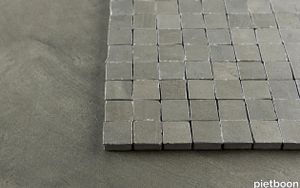
pietboon > Floor tile-stone
The TINY CONCRETE is a playful mosaic version of the CONCRETE series. The collection reflects the natural properties of concrete and shows no repetition of pattern, making each tile unique and indistinguishable from the real thing. Combining the two formats creates a harmonious whole. Moreover, the subdued color tones of this tile seamlessly match the characteristic color palette of the entire Piet Boon collection. The TINY CONCRETE tile is available in several colors and of course offers the proven practical properties of ceramics.
u-light acoustic
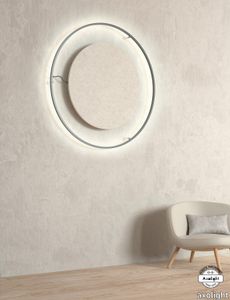
axolight > Ceiling lamp
U-light, in its wall and ceiling version, leaves the iconic U, in favor of an essential circular form. A ring, in which structure is inserted a LED, providing a white warm light. Thanks to its minimal design, U-light fits different styles, personalizing the spaces with a great scenic impact. Moreover, thanks to the installation of an acoustic panel, U-light has an Equivalent Sound Absorbing Area up to 2.49, that allows to reduce the noise as far as 44%.
Terra Nova Mediterraneo Decorative Tile: Bella 4
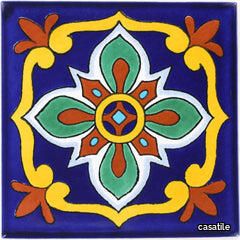
casatile > Floor tile-stone
Terra Nova Mediterraneo Tiles are made using the Maiolica ceramic technique. First, a tin-glaze layer on a terracotta tile is applied, then the tile is decorated over the glazed surface with other color glazes, and lastly it is fired in a kiln until it reaches the desired finish. The name Maiolica is thought to come from the medieval Italian word for Majorca, an island in the Mediterranean on the route followed by ships bringing Hispano-Moresque wares from Valencia to Italy. Moorish potters from Majorca are reputed to have worked in Sicily and it has been suggested that their wares reached the Italian mainland from Caltagirone, a town in the island of Sicily. Terra Nova tile collection delivers the stunning design and aesthetic solutions of authentic, old-world handcrafted decorative tiles, and at the same time meets technical requirements for applications of greater stress.
Terra Nova Mediterraneo Decorative Tile: Salermo 1
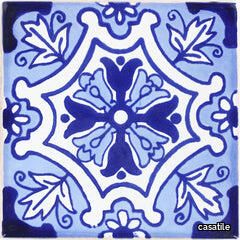
casatile > Floor tile-stone
Terra Nova Mediterraneo Tiles are made using the Maiolica ceramic technique. First, a tin-glaze layer on a terracotta tile is applied, then the tile is decorated over the glazed surface with other color glazes, and lastly it is fired in a kiln until it reaches the desired finish. The name Maiolica is thought to come from the medieval Italian word for Majorca, an island in the Mediterranean on the route followed by ships bringing Hispano-Moresque wares from Valencia to Italy. Moorish potters from Majorca are reputed to have worked in Sicily and it has been suggested that their wares reached the Italian mainland from Caltagirone, a town in the island of Sicily. Terra Nova tile collection delivers the stunning design and aesthetic solutions of authentic, old-world handcrafted decorative tiles, and at the same time meets technical requirements for applications of greater stress.
Andaluz Terra Nova Mediterraneo Morocco: Light Blue
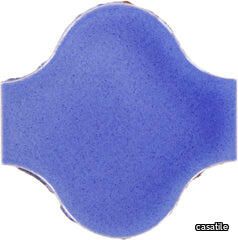
casatile > Floor tile-stone
Terra Nova Mediterraneo Tiles are made using the Maiolica ceramic technique. First, a tin-glaze layer on a terracotta tile is applied, then the tile is decorated over the glazed surface with other color glazes, and lastly it is fired in a kiln until it reaches the desired finish. The name Maiolica is thought to come from the medieval Italian word for Majorca, an island in the Mediterranean on the route followed by ships bringing Hispano-Moresque wares from Valencia to Italy. Moorish potters from Majorca are reputed to have worked in Sicily and it has been suggested that their wares reached the Italian mainland from Caltagirone, a town in the island of Sicily. Terra Nova tile collection delivers the stunning design and aesthetic solutions of authentic, old-world handcrafted decorative tiles, and at the same time meets technical requirements for applications of greater stress.
Andaluz Terra Nova Mediterraneo Andaluz: Light Green
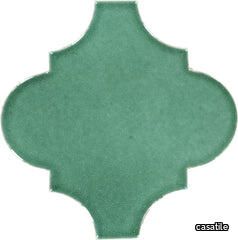
casatile > Floor tile-stone
Terra Nova Mediterraneo Tiles are made using the Maiolica ceramic technique. First, a tin-glaze layer on a terracotta tile is applied, then the tile is decorated over the glazed surface with other color glazes, and lastly it is fired in a kiln until it reaches the desired finish. The name Maiolica is thought to come from the medieval Italian word for Majorca, an island in the Mediterranean on the route followed by ships bringing Hispano-Moresque wares from Valencia to Italy. Moorish potters from Majorca are reputed to have worked in Sicily and it has been suggested that their wares reached the Italian mainland from Caltagirone, a town in the island of Sicily. Terra Nova tile collection delivers the stunning design and aesthetic solutions of authentic, old-world handcrafted decorative tiles, and at the same time meets technical requirements for applications of greater stress.
Araldica Base Corallo
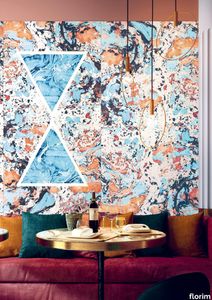
florim > Wall Paint
The miscellany of bright, contrasting, pure colours. The manifest extroversion of decor. The solutions provided to complete the range are in a different tone: reflecting the desire to "stage" a clear contrast with the multicolour ceramic wall coverings, these slabs are in completely neutral shades, in the grey frequencies of concrete.<br /><br />«The collection is intended to create a struggle, a fight. Between something very stiff, which sees itself as governed by clear rules, and a variable, marbled paper, which aims to be completely free.»<br />Federico Pepe "Once upon a time, there was a Roman emperor who lived on a huge splinter in space, a spaceship of multi-coloured marble, where techno music played incessantly. That day he left his spaceship to go to dinner at the Sun King's home, riding his sinuous golden dragon with blood-red eyes."If there were a book with these opening words, Federico Pepe would have designed its cover. And if the book were made into a film, he would definitely be its writer and director. Federico is not an author, director or screenwriter, but this does not prevent him from drawing on his natural ability to create stories through flashes of imagination.Federico Pepe's career started in advertising, a family tradition, which he gradually transformed and built into many other things, in a constant, inevitable investigation of creativity in all its possible forms. He very soon understood that commission work was not enough for him, and he began to explore further afield. The first of these other fields was art, but the consolidated mechanisms on which galleries and gallery owners operate soon became a new limit from which he had to break free: this apparently expanding horizon turned out to be a restrictive cage, more a defining label than an infinite learning opportunity. And definitions are one of the things which least describe Federico: anyone trying to distil his work into two words would find its essence disappearing before their own eyes. He has occupied many roles and engaged in many professions to give shape to his ideas, and in all of them he has excelled, created and led teams, and won awards. Adman, creative director, graphic designer, printer, gallery owner, publisher, curator, performer, painter, designer, director: Pepe does, rather than is, all these.<br /> He works, builds and makes things happen because he is not led by instinct alone and does not succumb to idle whim; he does not rush aimlessly around and does not simply await the inspiration or idea of the century. Quite the opposite. His work comes about and produces results only thanks to strict self-discipline, a design method made up of constant verification, the precise sharing of tasks and roles, the compulsive exploration of unknown contexts, daily physical exercise, the carefully measured use of social media, and occasional spells of isolation in the mountains he loves. It is no coincidence that he created Le Dictateur, a dual-faced entity which may be both his child and his spiritual guide, both friend and boss, part madness and part dictator. Le Dictateur is not Federico's alter ego: it is his superpower. It is not a mask, since in it he actually transforms himself into an artistic project.Le Dictateur is both result and origin of Federico Pepe's work. "I think ideas are born from predisposition," Federico explained to me in 2014. "Not in the sense that "˜we are born predisposed,' but for daily preparation. In this domain I believe that discipline is pivotal. The real talents today are very rigorous people, those who work hard, exchange a lot, think a lot, and know how to apply and balance many different things." An approach which has made him the best-kept secret on the Italian creative scene, a fact well known not only to Pierpaolo Ferrari, Maurizio Cattelan, Nico Vascellari, Jacopo Benassi and Patricia Urquiola, but also to the companies, both large and small, which have turned to him over the years. He has worked and continues to work with them all, designing by laying the foundations of designs naturally expressed in episodes, in a serial pattern which not only gradually builds up Federico's own creative story, but also offers his clients designs so special that they would be virtually impossible without him.<br /> This self-discipline generates heat and energy in such quantities that "“ if it were not imprisoned within the geometrical grids of graphic design "“ it might generate a thermonuclear reaction. The blood running through the veins of his images is black as ink, red as sealing-wax, white as plaster and golden as lava. But there is more, too. His crystal-clear visions are able to break down the slender membrane which separates analogue from digital. He sees matter as absolutely central, but he makes it vibrate with an unusual two-dimensional quality. This can be seen in the way he carves marble with coloured squiggles, recollections of faces briefly sketched as vectors. It is discovered in the skill with which he invades plates and bowls of the finest, monitor-shiny porcelain with geometrical patterns. It becomes tangible in the love with which he brings to life the paper of his publishing projects, peopled with highly elegant, powerfully symmetrical, often kaleidoscopic graphics. It can be admired in the precision with which a metallic factory flooring becomes fabric on an ancient loom, after its resolution is decreased from 300 dpi to 8 bits. It is enjoyed in the hyperbolic repetition of faces and hands in acrylic on canvas in his painting studio, in which every work conserves copy and paste reminders of its predecessor. It amazes in the doors of exquisite metal sideboards, profane glass panels, hand-made but born through the glass of a screen.<br /> A career which has led almost naturally to an encounter with CEDIT, with whom he has created an aesthetically courageous collection, part punk and part aristocratic austerity. The Araldica project's very name evokes strength and nobility, and it is grounded in a past whose weight does not drag it backwards but rather catapults it forwards into the future. Here, Federico's digital geometries become the most solid of materials, taking shape in a graphic object, condensing stories and images into three or two dimensions. In Pepe's and CEDIT's space, Euclidean geometrical forms encounter the marble of Phidias, the intricate patterns of the floor of Milan Cathedral merge into the Baroque images of the marbles found in Roman art galleries, and private space opens out to the infinite space of a thousand possible universal histories.
Ginger
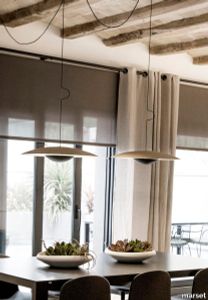
marset > Ceiling lamp
Wood is a great ally of cozy lighting. It is a material that is hard to mold, a challenge that the Ginger collection neatly resolves. The combination of sheets of wood, paper and resins pressed together under high pressure achieves a laminate that appears almost entirely flat, which discreetly lights up spaces with indirect light.This collection has been expanding over time to provide a solution to different lighting needs: different sizes for the suspension, tabletop (including the portable version) and floor models, two wall versions with a movable arm, and four wall lamp sizes that are simple yet formal and that can be combined with one another. The Ginger is also available in metal, offering the same warm, reflected light with no glare that helps highlight spaces. This material is applied to some models in the collection with different finishes: brushed brass, black or white on the outside, and brushed brass or white on the inside. A lighter, more refined, almost sculptural option. With these two highly diverse materials –wood and metal– the Ginger turns into a versatile collection, rounding out the circle and offering a lamp for every lighting and decorating need.
GOODMAN - Fabric sofa bed with removable cover _ Milano Bedding

Milano Bedding > Sofa
GOODMAN by Milano Bedding – Contemporary Sofa Bed with Tailored Form and Maximum Comfort Name: Goodman Material: Solid wood frame, polyurethane foam cushions, steel Lampolet mechanism Finishing: Fixed or removable fabric/leather upholstery, matt black painted metal legs Sizes (cm): Width 180–220 | Depth 102 | Height 83 | Bed size 140×200 or 160×200 Weight: Approx. 110–130 kg Designed in: Italy Collection: Milano Bedding Sofa Beds Lead Time: 30 days 2D/3D Files: Available for download Clean Design, Hidden Functionality The Goodman by Milano Bedding is a minimalist yet luxurious sofa bed, ideal for design-focused hotels, serviced apartments, offices, and contemporary homes. Its understated form hides a true bed within, featuring a 17 cm thick mattress for daily use comfort—without any need to remove cushions. Goodman’s visual identity is all about balance and proportion. With its low arms, generous depth, and structured seat cushions, it strikes a perfect blend between casual elegance and tailored precision. Craftsmanship, Comfort & Materials The frame is constructed from solid wood, ensuring durability and stability even in high-traffic environments like hospitality lounges and short-stay rentals. The cushions use high-resilience polyurethane foam, offering support for both sitting and sleeping. Upholstery options include removable fabric covers and premium leathers, available in a wide range of textures and tones—from neutral wools and linens to luxurious velvets and easy-clean contract fabrics. The piping detail along the arms and cushions enhances the clean geometry of the piece. The base is supported by discreet matt black painted metal legs, which give Goodman a modern, floating effect while maintaining structural strength. Designed for Hospitality, Residential & Contract Interiors Thanks to its compact yet spacious design, Goodman is ideal for: Boutique hotel rooms, suites, and apartments Urban flats and micro-living projects needing dual-function furniture Guest rooms or home offices Breakout areas in creative studios or corporate lounges High-end student accommodations or retail hospitality concepts Its easy-open Lampolet mechanism and removable upholstery make it perfectly suited for spaces where durability, hygiene, and design must co-exist. Visual Style and Interior Compatibility Goodman’s silhouette is defined by refined minimalism. The low-profile arms and precise seam lines give it a contemporary and architectural character, well suited to Scandinavian, Japandi, or urban loft interiors. The deep seat and wide arms add a welcoming sense of volume, making it ideal as a statement piece in living spaces or hospitality settings that favour warm minimalism or quiet luxury. It can be easily dressed up with cushions or left clean for a purist look. Key Features & Configurations Bed sizes: 140×200 cm and 160×200 cm 17 cm thick mattress in polyurethane or memory foam Opens easily without removing seat or back cushions Fixed or removable covers depending on fabric choice Optional scatter cushions, headrests, and storage accessories Similar Models to Explore Prefer a more decorative or softer look? Explore these Milano Bedding options: Jarreau – Wide arms and sculptural depth Marsalis – Mid-century inspired and architectural Clarke Quilted – Relaxed and casual with quilted textures Vivien – Slimmer, curvier silhouette for softer interiors All models are supported with 2D/3D files, perfect for CAD drawings, space planning, and digital presentations. Goodman by Milano Bedding delivers a masterclass in discreet sophistication—a sofa bed that combines technical performance and elegant design, perfect for high-spec interiors where versatility and style go hand-in-hand.
Original bed Pine green With Stitch headboard in Dew / Emerald and risers Dusty red
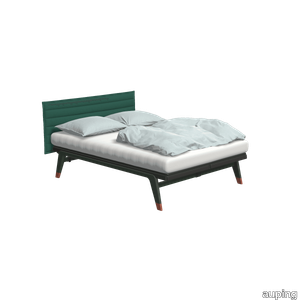
auping > Bed frame
The Original is a minimalist bed with strong lines. The steel frame with aluminium legs gives an elegant look. This variation in Pine green with a Stitch headboard in Dew / Emerald and Dusty red raised legs completes your bedroom. The bed is inspired by one of Auping's very first designs, the Cleopatra, and is available in ten colours. So chances are your favourite colour is among them. Designed in 2007, the Original is part of a family of iconic beds. The design was inspired by the Cleopatra, one of Auping's first design classics. In 2014, the Auping Original was awarded the Good Industrial Design (GIO) award. Besides design, this award is mainly about function, originality and innovation. In addition to this, the design must also be made with respect for people and the environment. Would you like to know more about the Original? Check out the Original lookbook. Have a look at the Original The Original is available with all our mattresses, change your choice in the configurator. Need help making a choice? In the configurator, go to the mattress selector for advice. Our collection consists of 5 beds that you can put together entirely as you wish. Choose your own colours, materials and accessories. In total, there are 2.8 billion possibilities in our online configurator. Looking for inspiration for your own bedroom or want to know more about our beds? Then take a look at the online lookbooks.
Araldica Base Blu

florim > Wall Paint
The miscellany of bright, contrasting, pure colours. The manifest extroversion of decor. The solutions provided to complete the range are in a different tone: reflecting the desire to "stage" a clear contrast with the multicolour ceramic wall coverings, these slabs are in completely neutral shades, in the grey frequencies of concrete.<br /><br />«The collection is intended to create a struggle, a fight. Between something very stiff, which sees itself as governed by clear rules, and a variable, marbled paper, which aims to be completely free.»<br />Federico Pepe "Once upon a time, there was a Roman emperor who lived on a huge splinter in space, a spaceship of multi-coloured marble, where techno music played incessantly. That day he left his spaceship to go to dinner at the Sun King's home, riding his sinuous golden dragon with blood-red eyes."If there were a book with these opening words, Federico Pepe would have designed its cover. And if the book were made into a film, he would definitely be its writer and director. Federico is not an author, director or screenwriter, but this does not prevent him from drawing on his natural ability to create stories through flashes of imagination.Federico Pepe's career started in advertising, a family tradition, which he gradually transformed and built into many other things, in a constant, inevitable investigation of creativity in all its possible forms. He very soon understood that commission work was not enough for him, and he began to explore further afield. The first of these other fields was art, but the consolidated mechanisms on which galleries and gallery owners operate soon became a new limit from which he had to break free: this apparently expanding horizon turned out to be a restrictive cage, more a defining label than an infinite learning opportunity. And definitions are one of the things which least describe Federico: anyone trying to distil his work into two words would find its essence disappearing before their own eyes. He has occupied many roles and engaged in many professions to give shape to his ideas, and in all of them he has excelled, created and led teams, and won awards. Adman, creative director, graphic designer, printer, gallery owner, publisher, curator, performer, painter, designer, director: Pepe does, rather than is, all these.<br /> He works, builds and makes things happen because he is not led by instinct alone and does not succumb to idle whim; he does not rush aimlessly around and does not simply await the inspiration or idea of the century. Quite the opposite. His work comes about and produces results only thanks to strict self-discipline, a design method made up of constant verification, the precise sharing of tasks and roles, the compulsive exploration of unknown contexts, daily physical exercise, the carefully measured use of social media, and occasional spells of isolation in the mountains he loves. It is no coincidence that he created Le Dictateur, a dual-faced entity which may be both his child and his spiritual guide, both friend and boss, part madness and part dictator. Le Dictateur is not Federico's alter ego: it is his superpower. It is not a mask, since in it he actually transforms himself into an artistic project.Le Dictateur is both result and origin of Federico Pepe's work. "I think ideas are born from predisposition," Federico explained to me in 2014. "Not in the sense that "˜we are born predisposed,' but for daily preparation. In this domain I believe that discipline is pivotal. The real talents today are very rigorous people, those who work hard, exchange a lot, think a lot, and know how to apply and balance many different things." An approach which has made him the best-kept secret on the Italian creative scene, a fact well known not only to Pierpaolo Ferrari, Maurizio Cattelan, Nico Vascellari, Jacopo Benassi and Patricia Urquiola, but also to the companies, both large and small, which have turned to him over the years. He has worked and continues to work with them all, designing by laying the foundations of designs naturally expressed in episodes, in a serial pattern which not only gradually builds up Federico's own creative story, but also offers his clients designs so special that they would be virtually impossible without him.<br /> This self-discipline generates heat and energy in such quantities that "“ if it were not imprisoned within the geometrical grids of graphic design "“ it might generate a thermonuclear reaction. The blood running through the veins of his images is black as ink, red as sealing-wax, white as plaster and golden as lava. But there is more, too. His crystal-clear visions are able to break down the slender membrane which separates analogue from digital. He sees matter as absolutely central, but he makes it vibrate with an unusual two-dimensional quality. This can be seen in the way he carves marble with coloured squiggles, recollections of faces briefly sketched as vectors. It is discovered in the skill with which he invades plates and bowls of the finest, monitor-shiny porcelain with geometrical patterns. It becomes tangible in the love with which he brings to life the paper of his publishing projects, peopled with highly elegant, powerfully symmetrical, often kaleidoscopic graphics. It can be admired in the precision with which a metallic factory flooring becomes fabric on an ancient loom, after its resolution is decreased from 300 dpi to 8 bits. It is enjoyed in the hyperbolic repetition of faces and hands in acrylic on canvas in his painting studio, in which every work conserves copy and paste reminders of its predecessor. It amazes in the doors of exquisite metal sideboards, profane glass panels, hand-made but born through the glass of a screen.<br /> A career which has led almost naturally to an encounter with CEDIT, with whom he has created an aesthetically courageous collection, part punk and part aristocratic austerity. The Araldica project's very name evokes strength and nobility, and it is grounded in a past whose weight does not drag it backwards but rather catapults it forwards into the future. Here, Federico's digital geometries become the most solid of materials, taking shape in a graphic object, condensing stories and images into three or two dimensions. In Pepe's and CEDIT's space, Euclidean geometrical forms encounter the marble of Phidias, the intricate patterns of the floor of Milan Cathedral merge into the Baroque images of the marbles found in Roman art galleries, and private space opens out to the infinite space of a thousand possible universal histories.
Cromatica Gradiente bianco-rosa
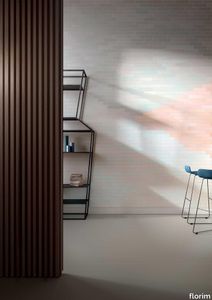
florim > Wall Paint
A lexicon of colour shades for mixing. A large size and its submultiples. «This work represents a reflection on colour, and above all a proposal on how to transfer the multiplicity of shades typical of a hand-crafted piece into a project produced on a large scale.» Andrea Trimarchi & Simone Farresin Studio Formafantasma base their work in the design world on a strong vocation for research. Simone Farresin and Andrea Trimarchi view every project as an opportunity for study and the acquisition of new knowledge, and their love of speculation establishes a dialectic rapport with the situations offered by each new client. Whether it involves a material, a type or a production method, the first phase of their design process is the mapping of what the specific case places at their disposal. With Cedit, an analysis of the company's past and present was central to the inputs. Inevitably, since "Looking back to look forward" has been the design duo's mission statement for years. In this case, in particular, the company's history was a real treasure trove, a fine blend of memory and technology: on the one hand, the excellence of production technologies now extended with the added potential arising from the engineering of large-sized ceramic tiles, and on the other a wealth of experience build up with great designers of the past, from Zanuso to Noorda, through to <strong>Ettore Sottsass</strong>. Andrea and Simone decided to focus on Sottsass - who started designing for Cedit back in the late Seventies - and made an in-depth study of one of the colour charts he developed towards the end of the Nineties. A spread of colours which gave its name to the "41 Colors" collection, included in the catalogue of the period as a real alphabet for what has proved to be a lasting design language. Colour was much more than just a compulsory step in the dialogue between designer and producer, since Sottsass had already discovered the power of the mystery intrinsic to this universe of invention.<br /><br />With Cedit the master-designer, a long-established lover of ceramics and their crafted unpredictability, found a way of transferring his personal feeling for colour to a wide audience, through industrial mass production. And this assumption is another factor Formafantasma have inherited, interpreting it today with new, even more efficient technical resources just as capable of expressing the secrets of colour. «The concept of colour "in isolation" - Sottsass explained in a 1992 text - classified colour, Pantone, as they call it now, "scientific" colour, is something I still refuse to accept. (...) Colours, the idea of colour, are always intangible, they slip slowly away like words, that run through your fingers, like poetry, which you can never keep hold of, like a good story.» And Formafantasma seem to have chosen that distinction between colour "in isolation" and "intangible" yet ever-present colour as the basis of their work. However, their approach draws on their unique vocation for research and the technical resources of the third millennium. «This work - they explain to us - is a reflection on colour, and above all on <strong>how to bring the multiplicity of shades typical of a hand-crafted piece into a large-scale project</strong>.» The designers look at large, monochrome slabs and turn to the engineers for details of their secrets, their processing stages, the phases in their production. They appreciate that the colour of ceramic material, its ineffable secret, can still be present in the series and large tile sizes in which Cedit leads the way. They understand that this is, in itself, an expressive power which does not need channelling into forms, motifs and signs. But above all, they treat the surface as a large canvas on which they spread pure colour, which tends to be uniform but in fact is never really a "scientific", totally monochrome hue: it is not a Pantone. And this is the source of the fundamental insight, which only children of the transition from the analogue to the digital era could achieve, the reward for those who draw on the past to look to the future.<br /><br />The designers cut the slab into lots of regular pieces, not necessarily of the same size. They restore its identity as a "tile", a familiar name with something ancient about it, but which stands for a module, a unit of measurement, a building block. There is nothing nostalgic about this - on the contrary, the vision is completely new, and the portions of slab created can be reassembled with no restrictions, breaking down the unity of the whole and reviving its essence starting from its structure. As the cards in the pack are shuffled, what emerges is not a figure or motif but the representation of colour itself and its physical nature. It is live matter, born from the meeting of vibrating forces, the mixing of ever-varying percentages of the basic ingredients. And Formafantasma present us with the corpuscular, fragmented essence of these small frames of space and crystallised time, which reveal the code and formula of their composition. So Cromatica is a collection made up of six colours which actually have an infinite number of declinations and compositional possibilities. It is a "discrete" combination in the mathematical sense of the term, capable of generating multiple, variable subsets. At the same time, each slab can be used in its entirety, leaving the impression of analogue continuity unchanged. But what really amazes is the comparison and dialogue between the two approaches: a stroke of genius, laying clear the mysterious appeal the artificial reproduction of colour has always held for mankind. Because, as Sottsass said, «colours are language, a powerful, magical, intangible, flexible, continuous material, in which existence is made manifest, the existence that lives in time and space».
Cromatica Grigio

florim > Wall Paint
A lexicon of colour shades for mixing. A large size and its submultiples. «This work represents a reflection on colour, and above all a proposal on how to transfer the multiplicity of shades typical of a hand-crafted piece into a project produced on a large scale.» Andrea Trimarchi & Simone Farresin Studio Formafantasma base their work in the design world on a strong vocation for research. Simone Farresin and Andrea Trimarchi view every project as an opportunity for study and the acquisition of new knowledge, and their love of speculation establishes a dialectic rapport with the situations offered by each new client. Whether it involves a material, a type or a production method, the first phase of their design process is the mapping of what the specific case places at their disposal. With Cedit, an analysis of the company's past and present was central to the inputs. Inevitably, since "Looking back to look forward" has been the design duo's mission statement for years. In this case, in particular, the company's history was a real treasure trove, a fine blend of memory and technology: on the one hand, the excellence of production technologies now extended with the added potential arising from the engineering of large-sized ceramic tiles, and on the other a wealth of experience build up with great designers of the past, from Zanuso to Noorda, through to <strong>Ettore Sottsass</strong>. Andrea and Simone decided to focus on Sottsass - who started designing for Cedit back in the late Seventies - and made an in-depth study of one of the colour charts he developed towards the end of the Nineties. A spread of colours which gave its name to the "41 Colors" collection, included in the catalogue of the period as a real alphabet for what has proved to be a lasting design language. Colour was much more than just a compulsory step in the dialogue between designer and producer, since Sottsass had already discovered the power of the mystery intrinsic to this universe of invention.<br /><br />With Cedit the master-designer, a long-established lover of ceramics and their crafted unpredictability, found a way of transferring his personal feeling for colour to a wide audience, through industrial mass production. And this assumption is another factor Formafantasma have inherited, interpreting it today with new, even more efficient technical resources just as capable of expressing the secrets of colour. «The concept of colour "in isolation" - Sottsass explained in a 1992 text - classified colour, Pantone, as they call it now, "scientific" colour, is something I still refuse to accept. (...) Colours, the idea of colour, are always intangible, they slip slowly away like words, that run through your fingers, like poetry, which you can never keep hold of, like a good story.» And Formafantasma seem to have chosen that distinction between colour "in isolation" and "intangible" yet ever-present colour as the basis of their work. However, their approach draws on their unique vocation for research and the technical resources of the third millennium. «This work - they explain to us - is a reflection on colour, and above all on <strong>how to bring the multiplicity of shades typical of a hand-crafted piece into a large-scale project</strong>.» The designers look at large, monochrome slabs and turn to the engineers for details of their secrets, their processing stages, the phases in their production. They appreciate that the colour of ceramic material, its ineffable secret, can still be present in the series and large tile sizes in which Cedit leads the way. They understand that this is, in itself, an expressive power which does not need channelling into forms, motifs and signs. But above all, they treat the surface as a large canvas on which they spread pure colour, which tends to be uniform but in fact is never really a "scientific", totally monochrome hue: it is not a Pantone. And this is the source of the fundamental insight, which only children of the transition from the analogue to the digital era could achieve, the reward for those who draw on the past to look to the future.<br /><br />The designers cut the slab into lots of regular pieces, not necessarily of the same size. They restore its identity as a "tile", a familiar name with something ancient about it, but which stands for a module, a unit of measurement, a building block. There is nothing nostalgic about this - on the contrary, the vision is completely new, and the portions of slab created can be reassembled with no restrictions, breaking down the unity of the whole and reviving its essence starting from its structure. As the cards in the pack are shuffled, what emerges is not a figure or motif but the representation of colour itself and its physical nature. It is live matter, born from the meeting of vibrating forces, the mixing of ever-varying percentages of the basic ingredients. And Formafantasma present us with the corpuscular, fragmented essence of these small frames of space and crystallised time, which reveal the code and formula of their composition. So Cromatica is a collection made up of six colours which actually have an infinite number of declinations and compositional possibilities. It is a "discrete" combination in the mathematical sense of the term, capable of generating multiple, variable subsets. At the same time, each slab can be used in its entirety, leaving the impression of analogue continuity unchanged. But what really amazes is the comparison and dialogue between the two approaches: a stroke of genius, laying clear the mysterious appeal the artificial reproduction of colour has always held for mankind. Because, as Sottsass said, «colours are language, a powerful, magical, intangible, flexible, continuous material, in which existence is made manifest, the existence that lives in time and space».
Kiruna Warm grey
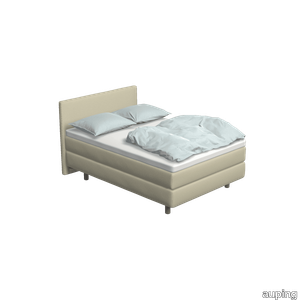
auping > Box spring
The Kiruna box spring is the most luxurious box spring. This is distinguished by the luxurious appearance and the use of natural materials. As soon as you lie down, you experience it yourself. This 2-person Kiruna box spring in the colour Warm grey with Sami mattress and Sami headboard upholstered in Plecto Beige gives your bed room a luxurious look. For the Kiruna box spring you can choose from 95 different fabrics. They each differ in colour and structure. In our stores you can see, feel and give you advice on which one fits best on the box spring of your choice. The luxurious Kiruna box spring has a refined design with attention to every detail and very high-quality finish. There are two headboards for the Kiruna: the slender and stylish Sami and the classic Unik. Or combine with one of the headboards of our Original box spring. To subtly add colour to the Kiruna box spring and to your bedroom, you can choose 1 of the ten Auping colours for the legs. Discover the Kiruna box spring The unique Kiruna mattresses have no less than 7 zones so that your body is perfectly supported and you lie down comfortably. The Sami mattress has a sleek finish, while the Unik mattress has an extra rich look due to graceful handles, a piping all around and refined side stitching. Our design collection consists of 5 beds and 4 box springs that you can put together completely according to your wishes. Choose your own colours, materials and accessories. In total, there are 2.8 billion possibilities in our online configurator. Looking for inspiration for your own bedroom or do you want to know more about our box springs? Then take a look at the online lookbooks.
Criade Deep black
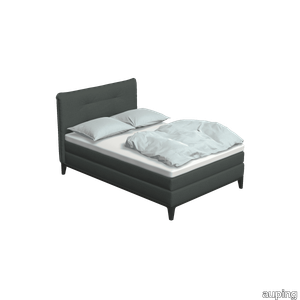
auping > Box spring
With its slender lines and refined details, the Criade is a sleek box spring with a distinctive design. The steel frame carries the design and the horizontal line connects the two box springs. This variant in Deep black with electric adjustable mesh base, topper and Cushion headboard in Facet / Dark grey is a real eye-catcher in your bedroom. The refined legs give the Criade's design an airy feel while the steel frame provides a solid base. Head and footboard are placed directly on the frame, leaving the floor free. The use of the different materials creates the design characteristic of Auping. The Criade is a richly padded box spring: the box contains a mesh base and pocket springs. The Auping mesh base is eighty percent open and therefore the box spring ventilates very well. The pocket springs in both the box spring and the mattress ensure that you can turn easily at night and have good support during your sleep. View the Criade box spring This Criade box spring includes Comfort mattress and Comfort topper. Want to make a different choice? The Criade box spring is available with all our mattresses and toppers, change your choice in the configurator. Our collection consists of 4 box springs that you can put together exactly as you wish. Choose your own colours, materials and accessories. In total, there are 2.8 billion possibilities in our online configurator. Looking for inspiration for your own bedroom or want to know more about our beds? Then take a look at the online lookbooks.
Oltremare Poltrona
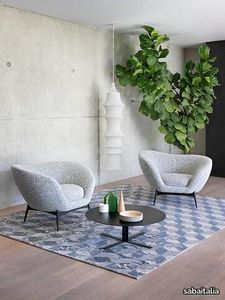
sabaitalia > Armchair
The seating collection “Oltremare” designed by Antonio Marras and produced in collaboration with Saba, stems from a far-away past and place, full of history, recollection, memories overflowing with suggestions and visions. And this is how Antonio Marras presented an object so dear to him that he defines a sacred-idol, that narrates of his land, of his sea, but mostly, of his story. We named it Oltremare, because all things have a soul and every soul has a name. Oltremare encloses within its inlets the classic and the modern. The curve is a line that can be tamed: it forms a wave, a fold, it creates a place but it also offers an escape route. In our utopian world we investigated the relationship between the curved line and the act of seating, asymmetric shapes that become backrests and sink into extremely comfortable seats pushing past the rectangular schemes so dear to the sober lines of designing sofas. The asymmetric curves that enclose it are the inspirations for the Oltremare armchair that completes the collection alongside a padded bench. A comfortable nest suspended on a slim varnished metal base, whose essential lines render, by contract, the armchair’s silhouette even more interesting. Oltremare is a seating system that, even though winks at the past, it communicates a strong contemporary soul and is suitable by nature to various interpretations. Fully removable covers.
Criade Cool grey
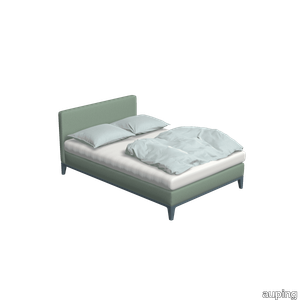
auping > Box spring
With its slender lines and refined details, the Criade is a sleek box spring with a distinctive design. The steel frame carries the design and the horizontal line connects the two box springs. This version in Cool grey with Plain headboard in Rewool / Ice blue is a real eye-catcher in your bedroom. The refined legs give the Criade's design an airy feel while the steel frame provides a solid base. The head and foot board rest directly on the frame, leaving the floor free. The use of the different materials creates the design characteristic of Auping. The Criade is a richly padded box spring: the box contains a mesh base and pocket springs. The Auping mesh base is eighty percent open and therefore the box spring ventilates very well. The pocket springs in both the box spring and the mattress ensure that you can turn easily at night and have good support during your sleep. View the Criade box spring This Criade box spring includes the Inizio mattress. Want to make a different choice? The Criade box spring is available with all our mattresses and toppers, change your choice in the configurator. Our collection consists of 4 box springs that you can put together exactly as you wish. Choose your own colours, materials and accessories. In total, there are 2.8 billion possibilities in our online configurator. Looking for inspiration for your own bedroom or want to know more about our beds? Then take a look at the online lookbooks.
Sendai
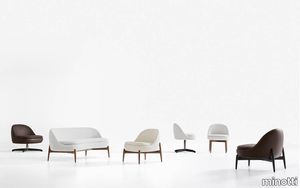
minotti > Armchair
Named after the city of trees, Sendai, this line of furnishing pieces consists of a small sofa, an armchair, a lounge armchair and dining and lounge little armchairs. Like slender trunks, the elegant, polished legs, in Canaletto walnut solid wood stained Light Brown, or Licorice lacquered ash, rest on the ground, lifting the enveloping upholstered body and creating a soft rhythm of vertical lines. The possibility of having the armchair, the dining little armchair and the lounge armchair also in the 360° swivel version with return (base in polished Bronze-coloured varnished metal, with sheathed spokes in solid ash with an open-pore Licorice-coloured lacquer, or in solid Canaletto walnut with Light Brown stain) makes the Sendai seats particularly comfortable for both residential and hospitality environments. The compact and well-proportioned silhouette of both the seats and the small sofa, opens up to a new way of using the dining space: as a living room within the living room, a hybrid situation, such as when dinner is served on a large table, while guests meet and socialise round a lounge table. A new, more intimate way of opening up new visual and proportional horizons of the living space, both in homes and in hospitality veues. In 2023, the elegant and airy Sendai family of seats expands, with a new enveloping sofa, a comfortable swivel armchair with armrests and a footstool. The design of the armchair, with its upholstered frame resting on a 360° swivel base with return mechanism, also stems from the desire to have a larger seat whose comfort is ensured by a higher backrest and the presence of comfortable armrests, perfect for ensuring a satisfying sensation of relaxation, especially when used in combination with the footrest.
SODA - Porcelain stoneware wall/floor tiles _ gruppo bardelli
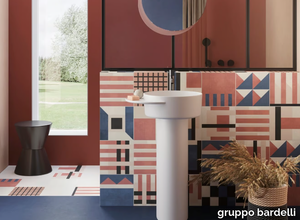
gruppo bardelli > Wall tile-stone-brick
Soda by Ceramica Bardelli: A Contemporary Take on Classic Cement Tiles The Soda collection by Ceramica Bardelli brings the timeless charm of traditional cement tiles into modern interiors and exteriors. Crafted from high-quality rectified porcelain stoneware, Soda tiles combine durability with sophisticated design, offering endless opportunities for creative expression in residential and non-residential spaces alike. Design and Features Soda is available in a versatile 25x25 cm (10"x10") square format, with a robust thickness of 1 cm (25/64"). The tiles feature a matte finish with a slightly antiqued look, reminiscent of vintage cement tiles but with the added performance of porcelain stoneware. The collection includes: 16 unique decorative tiles, supplied randomly assorted and designed for the patchwork technique. 3 solid colours (ivory, light grey, and dove grey) that perfectly match the decorative tiles, enabling seamless transitions between patterns and solids. This combination of geometric designs and neutral tones provides a harmonious blend of tradition and modernity, ideal for creating spaces with a strong expressive character. Colour Variants and Versatility The collection is available in three distinct colour palettes—Soda1, Soda2, and Soda3—each offering its unique mix of tones and patterns. This variety allows designers to personalise spaces with combinations that reflect their vision, from vibrant patchwork designs to more subdued and elegant compositions using matching solid colours. The tiles are suitable for both flooring and wall cladding, and their R10-rated anti-slip properties make them an excellent choice for indoor and outdoor applications, including kitchens, bathrooms, patios, and commercial spaces. Creative Freedom with Patchwork The patchwork technique offers infinite possibilities for customisation, enabling the creation of truly unique designs. By combining the 16 decorative patterns with the solid backgrounds, designers can experiment with layouts that range from eclectic and dynamic to minimalistic and structured, making Soda adaptable to a variety of architectural styles. Applications and Aesthetic Soda’s versatility makes it perfect for a range of settings, from contemporary homes to hospitality and commercial spaces. Its slightly aged finish adds warmth and character, while its geometric motifs and neutral tones ensure it complements both modern and classic interiors. About Ceramica Bardelli Ceramica Bardelli, part of the esteemed Gruppo Bardelli, is a leader in Italian ceramic innovation. With production facilities in Cerrione and Oderzo, the Group is renowned for combining craftsmanship with cutting-edge technology to create tiles that inspire and elevate design. The Soda collection exemplifies this ethos, offering a refined yet practical solution for designers seeking to create expressive and functional spaces. For seamless design integration, downloadable 3D files are available, ensuring precision in project visualisation and execution. With its blend of tradition, innovation, and artistic freedom, Soda transforms floors and walls into works of art.